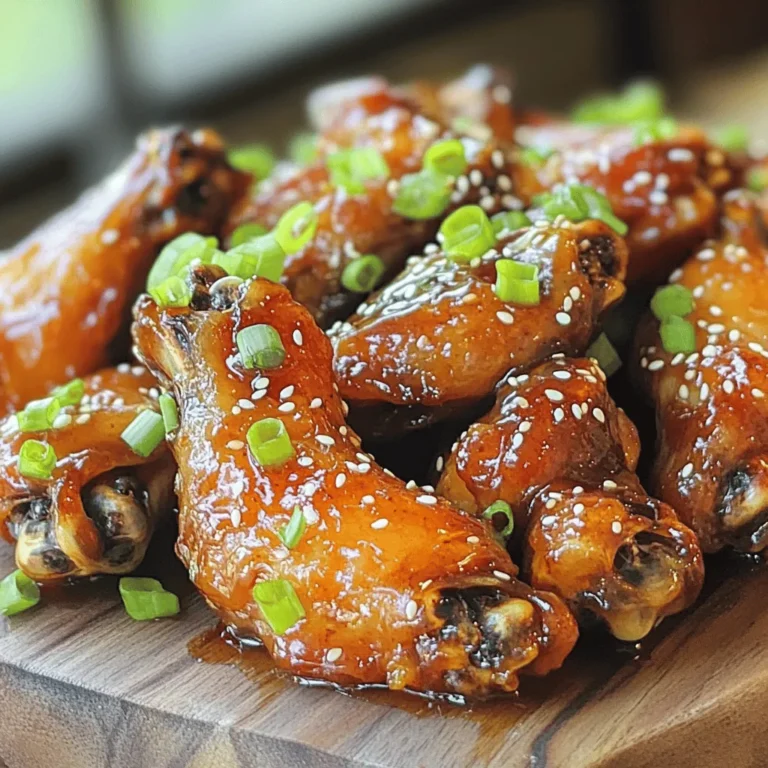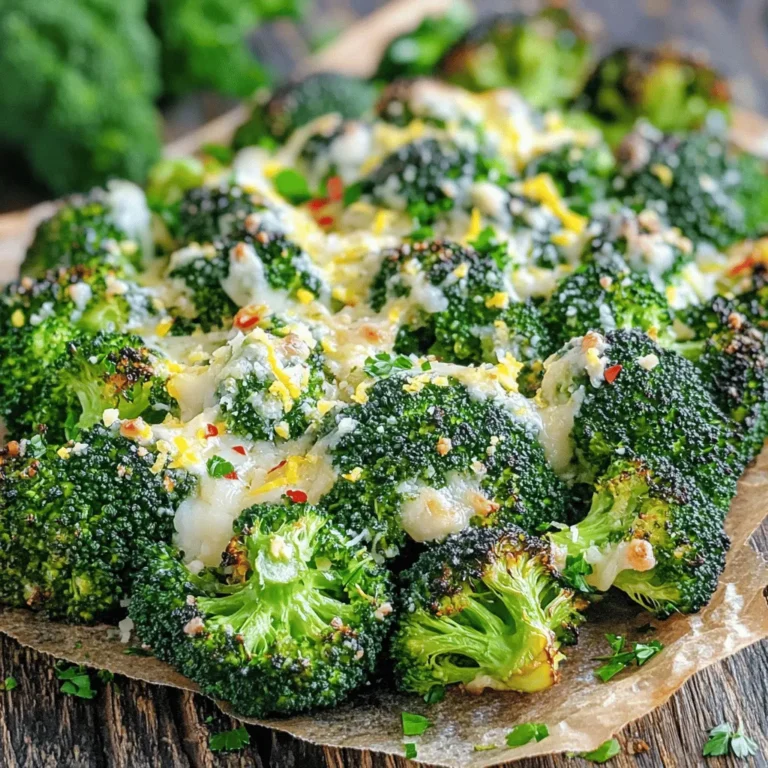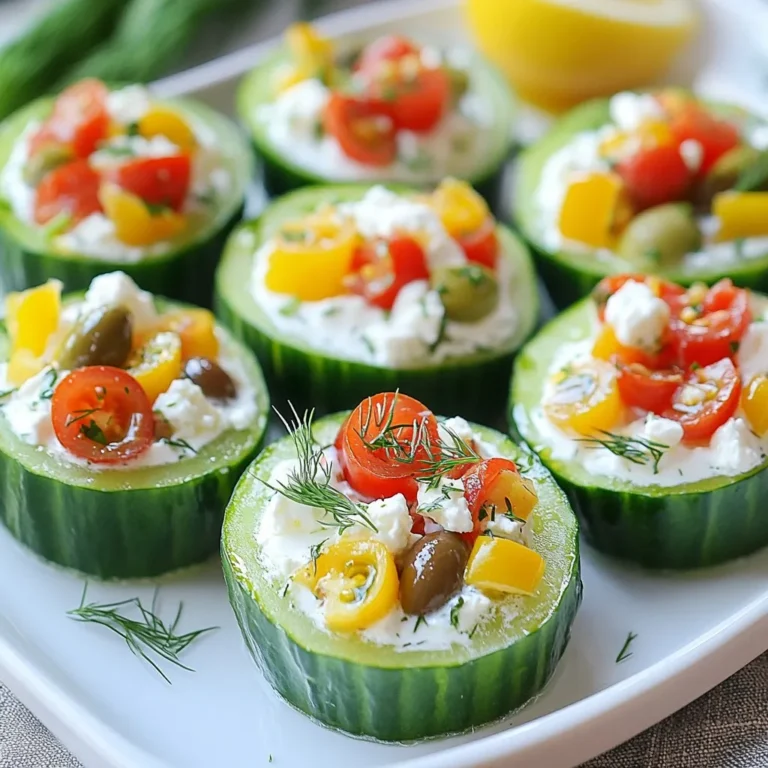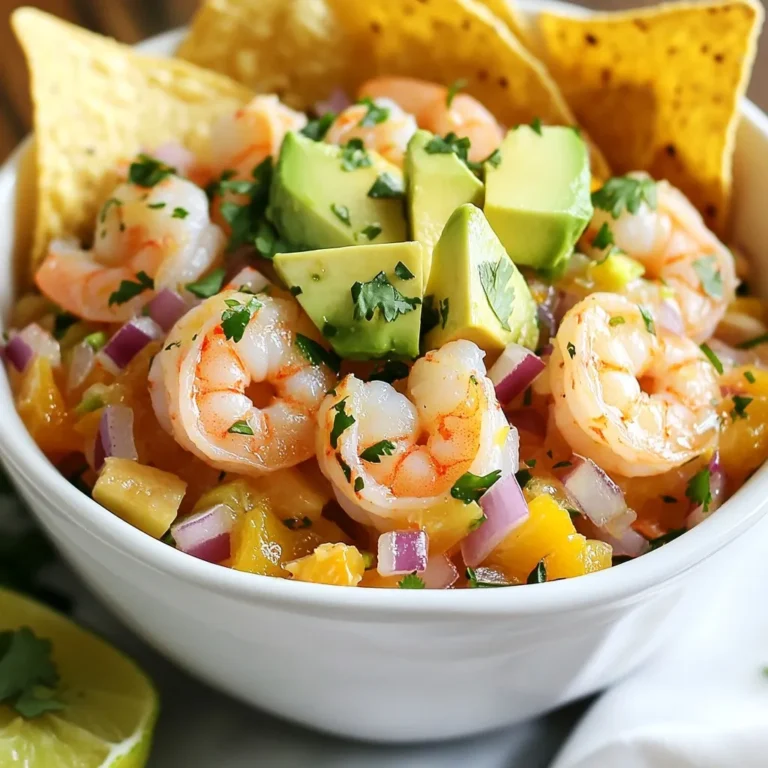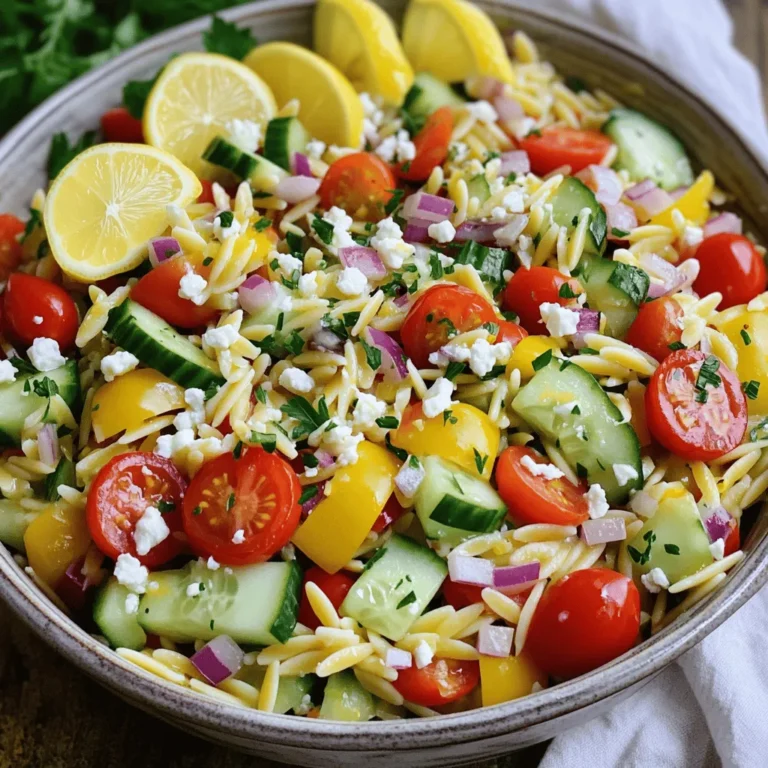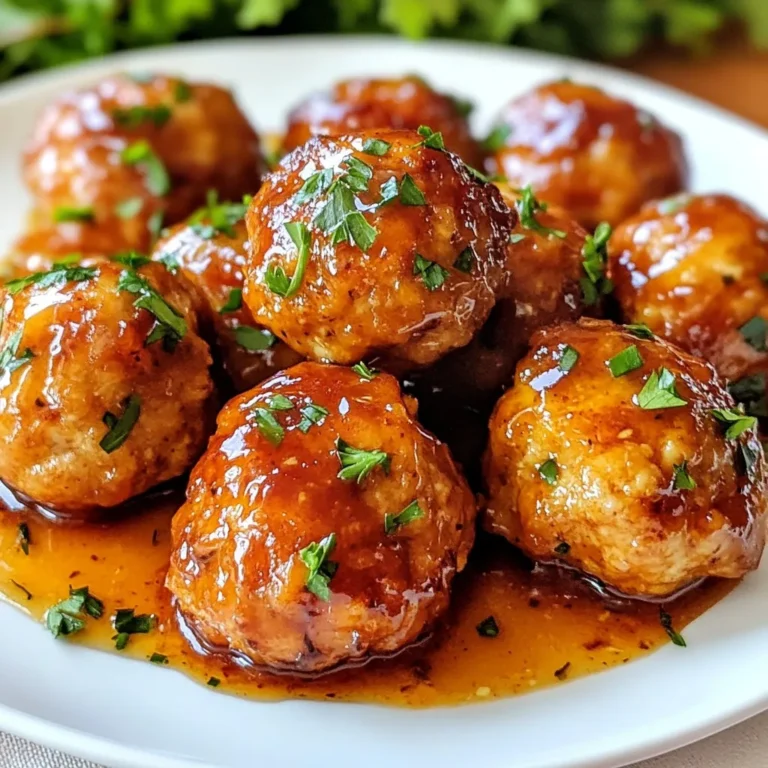Vegetable Spring Rolls Simple and Fresh Recipe
![- 10 rice paper wrappers - 1 cup shredded carrots - 1 cup red cabbage, finely sliced - 1 cup cucumber, julienned - 1 red bell pepper, thinly sliced - 1 avocado, thinly sliced - 1 cup fresh mint leaves - 1 cup fresh cilantro leaves - 1 tablespoon soy sauce - 1 tablespoon sesame oil - Salt to taste - Optional: Thai chili sauce for dipping To make fresh vegetable spring rolls, you need a few key items. First, rice paper wrappers form the base. They are light and flexible. Next, fresh vegetables add crunch and color. Carrots, cabbage, cucumber, bell pepper, and avocado work great. Each adds its unique taste. Finally, flavor enhancers like soy sauce and sesame oil bring everything together. You can switch out some veggies if needed. Try using lettuce or spinach instead of cabbage. If you don't have a red bell pepper, use a yellow or green one. For a gluten-free option, ensure you pick gluten-free soy sauce. This keeps your rolls safe for all diets. Feel free to get creative with your rolls. Add fresh herbs like basil or cilantro for extra flavor. You can also try spices like ginger or garlic. For dipping, consider peanut sauce or sweet chili sauce. These will add a fun twist to each bite. For the full recipe, don't forget to check out the [Full Recipe]. - Washing and cutting vegetables Start by washing all your vegetables. This step is key for fresh spring rolls. Use cold water to clean them well. After washing, chop the veggies. Shred the carrots, slice the cabbage, julienne the cucumber, and thinly slice the bell pepper and avocado. Place each cut veggie in its own bowl. This makes it easier to grab when assembling. - Soaking rice paper wrappers For the rice paper, grab a shallow dish and fill it with warm water. Dip one rice paper wrapper into the water. Let it soak for about 10-15 seconds. You want it soft, but not too mushy. Carefully lift it out and place it flat on a clean surface. Repeat this for each wrapper as you go. - Layering ingredients effectively Place the rice paper so one edge is closest to you. On the lower third of the wrapper, add a handful of shredded carrots. Next, layer in the red cabbage, cucumber, bell pepper, and avocado. Add a few mint and cilantro leaves on top. A pinch of salt enhances flavor. Drizzle a bit of soy sauce and sesame oil across the veggies for an extra kick. - Rolling techniques for a secure wrap Now for the fun part—rolling! Lift the edge closest to you and fold it over the filling. Tuck in the sides tightly. This way, nothing spills out. Continue rolling away from you until the spring roll is fully wrapped. Make sure it’s snug. Repeat this until you use up all the wrappers and fillings. - Plating ideas for an appealing presentation Arrange the completed spring rolls on a bright platter. For a pop of color, add extra mint and cilantro leaves around them. Place a small bowl of Thai chili sauce in the center for dipping. This makes the dish look inviting and tasty. - Chilling versus room temperature serving You can serve the spring rolls right away or chill them in the fridge. Chilled rolls offer a refreshing bite. If you prefer them at room temperature, they still taste great. Either way, enjoy your delicious creation! For the complete recipe, check the [Full Recipe]. To avoid tearing rice paper, keep a few things in mind: - Soak briefly: Submerge the rice paper in warm water for just 10-15 seconds. It should feel soft but not too mushy. - Use a clean surface: Lay the rice paper on a dry, flat surface to prevent sticking. - Layer lightly: Don’t overload the wrapper with too many veggies. A small handful works best. Maintaining freshness of the rolls is also key: - Wrap tightly: After filling, roll the rice paper snugly to keep the ingredients inside. - Serve with care: Arrange the rolls on a platter and cover them with a damp cloth until ready to eat. - Chill for a crisp bite: If you have time, refrigerate them for about 30 minutes before serving. The best dipping sauces for spring rolls include: - Thai chili sauce: This adds a sweet and spicy kick. - Peanut sauce: Creamy and rich, it pairs well with fresh veggies. - Soy sauce: A classic choice, it adds a salty depth to each bite. When pairing with beverages, consider: - Green tea: Its light flavor enhances the fresh taste of the rolls. - Coconut water: This adds a refreshing, tropical touch. - Sparkling water: It cleanses the palate between bites. To store leftover spring rolls: - Refrigerate: Place them in an airtight container, separated by parchment paper. This keeps them fresh. - Use within 2 days: For the best taste, enjoy them quickly. For reheating instructions: - Avoid the microwave: It can make the rice paper chewy. - Oven method: Preheat the oven to 350°F. Place rolls on a baking sheet and heat for about 10 minutes or until warm. Following these tips will help you enjoy your vegetable spring rolls at their best! If you want full details on how to make them, check out the Full Recipe. {{image_4}} You can easily adapt vegetable spring rolls to fit your diet. - Vegan variations: All the ingredients in this recipe are plant-based. You can use tofu for added protein. Just cube it and sauté it lightly. This adds flavor and texture. - Low-carb options: For a low-carb version, skip the rice paper. Instead, use lettuce leaves. They wrap well and give a nice crunch. Changing flavors can make these spring rolls exciting. - Spicy versions with chili: If you love heat, add sliced chili peppers. You can mix them with the veggies or use them as a topping. This gives your spring rolls a nice kick. - Sweet versions with fruits: For a fun twist, use fruits like mango or pineapple. Slice them thinly and add them to the filling. They bring a refreshing sweetness. Serving spring rolls differently can impress your guests. - Spring roll salads: Chop your spring rolls into bite-sized pieces and toss them in a salad. Add your favorite dressing for a unique dish. - Spring roll bowls: Place the rolled spring rolls in a bowl with rice or quinoa. Add a drizzle of sauce and top with fresh herbs. This makes a hearty meal. You can explore these variations and create your own unique rolls. Check the Full Recipe for more details! Vegetable spring rolls stay fresh in the fridge for about three days. To keep them from getting soggy, place a damp paper towel in the container. This helps keep the rice paper soft yet not wet. Also, store them in an airtight container to prevent drying out. You can freeze spring rolls for up to two months. To do this, lay them flat on a baking sheet. Freeze them for about one hour, then transfer them to a freezer bag. This helps keep them from sticking together. When it’s time to enjoy, thaw the rolls overnight in the fridge. You have options when reheating. For a crispier finish, use the oven. Preheat it to 350°F (175°C), then bake the rolls for about 10 minutes. If you prefer a quick method, the microwave works too. Just heat them for 30 seconds but be careful; this can make them soft. Always check that the rice paper stays crispy for the best bite. To keep your vegetable spring rolls crispy, avoid over-soaking the rice paper. Dip it in warm water for just 10-15 seconds. Use fresh, dry vegetables. If you prepare them ahead of time, store them in an airtight container with a damp paper towel. This keeps moisture at bay and helps maintain crunch. Yes, you can make vegetable spring rolls ahead of time. Prepare them a few hours before serving. To keep them fresh, place them in a single layer on a plate. Cover them with a damp cloth. This helps prevent them from drying out. However, it’s best to eat them within a day for optimal taste. Serve your spring rolls on a colorful platter. This makes them look inviting. You can chill them in the fridge or serve them at room temperature. Pair them with a bowl of Thai chili sauce for dipping. You can also add hoisin or peanut sauce for extra flavor. Yes, store-bought dips work well with vegetable spring rolls. Look for sweet chili sauce, hoisin sauce, or peanut sauce. Each adds a unique twist. Make sure to choose a dip that balances the fresh flavors of the rolls. Enjoy experimenting with different dips! In this article, we explored how to make fresh and delicious spring rolls. We looked at essential ingredients, possible substitutions, and optional additions to enhance flavor. The step-by-step instructions made preparation easy, from washing veggies to perfect rolling techniques. I shared tips for serving and storing your rolls, along with various tasty variations. Spring rolls are fun and simple to make. With the right tips, you can enjoy fresh rolls anytime. Try new flavors and enjoy your creations!](https://blissfulmeal.com/wp-content/uploads/2025/06/43dc254c-4e59-4d22-bcd3-66be98d8c99d.webp)
Looking for a fresh and easy snack? My Vegetable Spring Rolls recipe is just what you need! With crisp veggies wrapped in soft rice paper, these rolls are not only delightful but also healthy. Whether you want to dip them in sauces or enjoy them plain, this guide walks you through each step. Ready to roll? Let’s dive into the flavors and fun of making your own spring rolls!
Ingredients
Essential Ingredients
– 10 rice paper wrappers
– 1 cup shredded carrots
– 1 cup red cabbage, finely sliced
– 1 cup cucumber, julienned
– 1 red bell pepper, thinly sliced
– 1 avocado, thinly sliced
– 1 cup fresh mint leaves
– 1 cup fresh cilantro leaves
– 1 tablespoon soy sauce
– 1 tablespoon sesame oil
– Salt to taste
– Optional: Thai chili sauce for dipping
To make fresh vegetable spring rolls, you need a few key items. First, rice paper wrappers form the base. They are light and flexible. Next, fresh vegetables add crunch and color. Carrots, cabbage, cucumber, bell pepper, and avocado work great. Each adds its unique taste. Finally, flavor enhancers like soy sauce and sesame oil bring everything together.
Ingredient Substitutions
You can switch out some veggies if needed. Try using lettuce or spinach instead of cabbage. If you don’t have a red bell pepper, use a yellow or green one. For a gluten-free option, ensure you pick gluten-free soy sauce. This keeps your rolls safe for all diets.
Optional Additions
Feel free to get creative with your rolls. Add fresh herbs like basil or cilantro for extra flavor. You can also try spices like ginger or garlic. For dipping, consider peanut sauce or sweet chili sauce. These will add a fun twist to each bite.
Step-by-Step Instructions
Preparation Steps
– Washing and cutting vegetables
Start by washing all your vegetables. This step is key for fresh spring rolls. Use cold water to clean them well. After washing, chop the veggies. Shred the carrots, slice the cabbage, julienne the cucumber, and thinly slice the bell pepper and avocado. Place each cut veggie in its own bowl. This makes it easier to grab when assembling.
– Soaking rice paper wrappers
For the rice paper, grab a shallow dish and fill it with warm water. Dip one rice paper wrapper into the water. Let it soak for about 10-15 seconds. You want it soft, but not too mushy. Carefully lift it out and place it flat on a clean surface. Repeat this for each wrapper as you go.
Assembly Process
– Layering ingredients effectively
Place the rice paper so one edge is closest to you. On the lower third of the wrapper, add a handful of shredded carrots. Next, layer in the red cabbage, cucumber, bell pepper, and avocado. Add a few mint and cilantro leaves on top. A pinch of salt enhances flavor. Drizzle a bit of soy sauce and sesame oil across the veggies for an extra kick.
– Rolling techniques for a secure wrap
Now for the fun part—rolling! Lift the edge closest to you and fold it over the filling. Tuck in the sides tightly. This way, nothing spills out. Continue rolling away from you until the spring roll is fully wrapped. Make sure it’s snug. Repeat this until you use up all the wrappers and fillings.
Serving Suggestions
– Plating ideas for an appealing presentation
Arrange the completed spring rolls on a bright platter. For a pop of color, add extra mint and cilantro leaves around them. Place a small bowl of Thai chili sauce in the center for dipping. This makes the dish look inviting and tasty.
– Chilling versus room temperature serving
You can serve the spring rolls right away or chill them in the fridge. Chilled rolls offer a refreshing bite. If you prefer them at room temperature, they still taste great. Either way, enjoy your delicious creation!
Tips & Tricks
Best Rolling Practices
To avoid tearing rice paper, keep a few things in mind:
– Soak briefly: Submerge the rice paper in warm water for just 10-15 seconds. It should feel soft but not too mushy.
– Use a clean surface: Lay the rice paper on a dry, flat surface to prevent sticking.
– Layer lightly: Don’t overload the wrapper with too many veggies. A small handful works best.
Maintaining freshness of the rolls is also key:
– Wrap tightly: After filling, roll the rice paper snugly to keep the ingredients inside.
– Serve with care: Arrange the rolls on a platter and cover them with a damp cloth until ready to eat.
– Chill for a crisp bite: If you have time, refrigerate them for about 30 minutes before serving.
Serving Recommendations
The best dipping sauces for spring rolls include:
– Thai chili sauce: This adds a sweet and spicy kick.
– Peanut sauce: Creamy and rich, it pairs well with fresh veggies.
– Soy sauce: A classic choice, it adds a salty depth to each bite.
When pairing with beverages, consider:
– Green tea: Its light flavor enhances the fresh taste of the rolls.
– Coconut water: This adds a refreshing, tropical touch.
– Sparkling water: It cleanses the palate between bites.
Storage Tips
To store leftover spring rolls:
– Refrigerate: Place them in an airtight container, separated by parchment paper. This keeps them fresh.
– Use within 2 days: For the best taste, enjoy them quickly.
For reheating instructions:
– Avoid the microwave: It can make the rice paper chewy.
– Oven method: Preheat the oven to 350°F. Place rolls on a baking sheet and heat for about 10 minutes or until warm.
Following these tips will help you enjoy your vegetable spring rolls at their best!
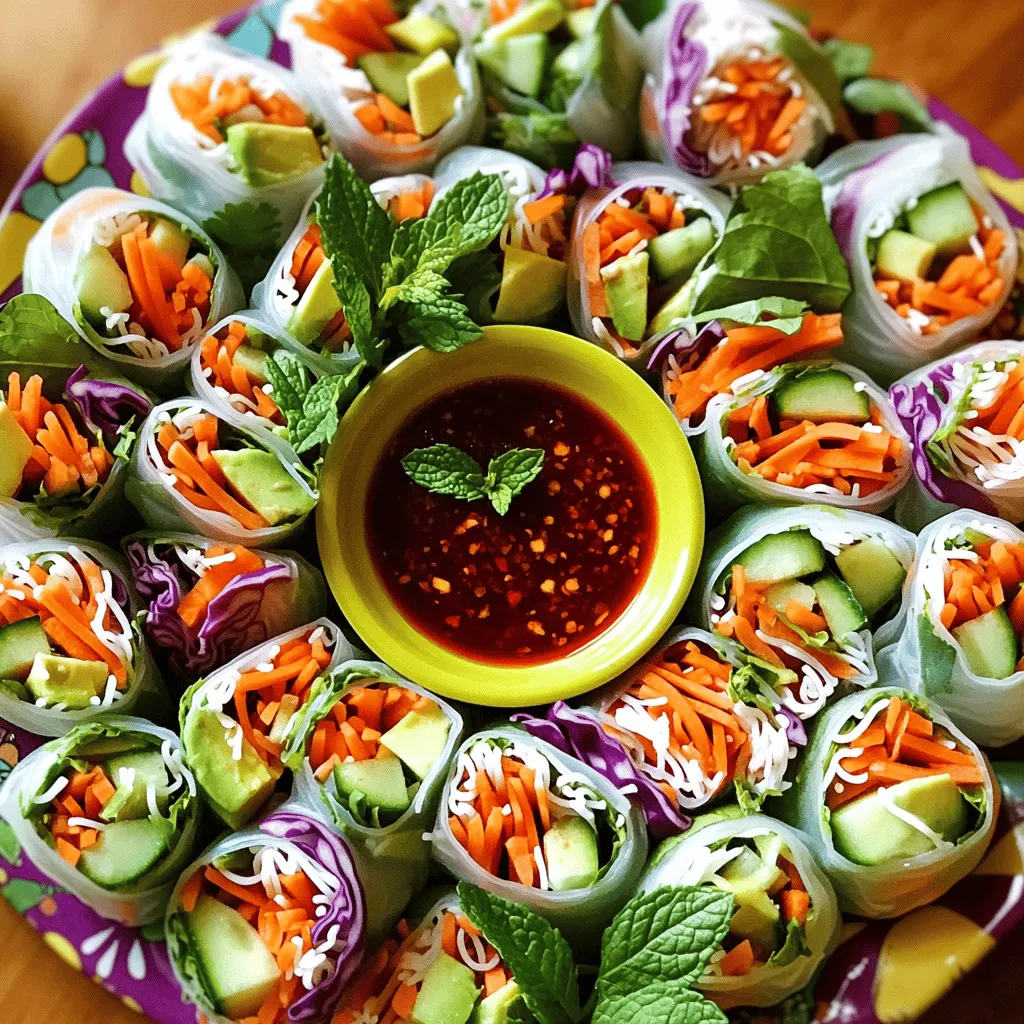
Variations
Dietary Considerations
You can easily adapt vegetable spring rolls to fit your diet.
– Vegan variations: All the ingredients in this recipe are plant-based. You can use tofu for added protein. Just cube it and sauté it lightly. This adds flavor and texture.
– Low-carb options: For a low-carb version, skip the rice paper. Instead, use lettuce leaves. They wrap well and give a nice crunch.
Flavor Profiles
Changing flavors can make these spring rolls exciting.
– Spicy versions with chili: If you love heat, add sliced chili peppers. You can mix them with the veggies or use them as a topping. This gives your spring rolls a nice kick.
– Sweet versions with fruits: For a fun twist, use fruits like mango or pineapple. Slice them thinly and add them to the filling. They bring a refreshing sweetness.
Creative Serving Ideas
Serving spring rolls differently can impress your guests.
– Spring roll salads: Chop your spring rolls into bite-sized pieces and toss them in a salad. Add your favorite dressing for a unique dish.
– Spring roll bowls: Place the rolled spring rolls in a bowl with rice or quinoa. Add a drizzle of sauce and top with fresh herbs. This makes a hearty meal.
You can explore these variations and create your own unique rolls.
Storage Info
Refrigeration Guidelines
Vegetable spring rolls stay fresh in the fridge for about three days. To keep them from getting soggy, place a damp paper towel in the container. This helps keep the rice paper soft yet not wet. Also, store them in an airtight container to prevent drying out.
Freezing Instructions
You can freeze spring rolls for up to two months. To do this, lay them flat on a baking sheet. Freeze them for about one hour, then transfer them to a freezer bag. This helps keep them from sticking together. When it’s time to enjoy, thaw the rolls overnight in the fridge.
Reheating Methods
You have options when reheating. For a crispier finish, use the oven. Preheat it to 350°F (175°C), then bake the rolls for about 10 minutes. If you prefer a quick method, the microwave works too. Just heat them for 30 seconds but be careful; this can make them soft. Always check that the rice paper stays crispy for the best bite.
FAQs
How do you keep vegetable spring rolls from getting soggy?
To keep your vegetable spring rolls crispy, avoid over-soaking the rice paper. Dip it in warm water for just 10-15 seconds. Use fresh, dry vegetables. If you prepare them ahead of time, store them in an airtight container with a damp paper towel. This keeps moisture at bay and helps maintain crunch.
Can I make vegetable spring rolls in advance?
Yes, you can make vegetable spring rolls ahead of time. Prepare them a few hours before serving. To keep them fresh, place them in a single layer on a plate. Cover them with a damp cloth. This helps prevent them from drying out. However, it’s best to eat them within a day for optimal taste.
What is the best way to serve spring rolls?
Serve your spring rolls on a colorful platter. This makes them look inviting. You can chill them in the fridge or serve them at room temperature. Pair them with a bowl of Thai chili sauce for dipping. You can also add hoisin or peanut sauce for extra flavor.
Can I use store-bought dip for spring rolls?
Yes, store-bought dips work well with vegetable spring rolls. Look for sweet chili sauce, hoisin sauce, or peanut sauce. Each adds a unique twist. Make sure to choose a dip that balances the fresh flavors of the rolls. Enjoy experimenting with different dips!
In this article, we explored how to make fresh and delicious spring rolls. We looked at essential ingredients, possible substitutions, and optional additions to enhance flavor. The step-by-step instructions made preparation easy, from washing veggies to perfect rolling techniques. I shared tips for serving and storing your rolls, along with various tasty variations.
Spring rolls are fun and simple to make. With the right tips, you can enjoy fresh rolls anytime. Try new flavors and enjoy your creations!
![- 10 rice paper wrappers - 1 cup shredded carrots - 1 cup red cabbage, finely sliced - 1 cup cucumber, julienned - 1 red bell pepper, thinly sliced - 1 avocado, thinly sliced - 1 cup fresh mint leaves - 1 cup fresh cilantro leaves - 1 tablespoon soy sauce - 1 tablespoon sesame oil - Salt to taste - Optional: Thai chili sauce for dipping To make fresh vegetable spring rolls, you need a few key items. First, rice paper wrappers form the base. They are light and flexible. Next, fresh vegetables add crunch and color. Carrots, cabbage, cucumber, bell pepper, and avocado work great. Each adds its unique taste. Finally, flavor enhancers like soy sauce and sesame oil bring everything together. You can switch out some veggies if needed. Try using lettuce or spinach instead of cabbage. If you don't have a red bell pepper, use a yellow or green one. For a gluten-free option, ensure you pick gluten-free soy sauce. This keeps your rolls safe for all diets. Feel free to get creative with your rolls. Add fresh herbs like basil or cilantro for extra flavor. You can also try spices like ginger or garlic. For dipping, consider peanut sauce or sweet chili sauce. These will add a fun twist to each bite. For the full recipe, don't forget to check out the [Full Recipe]. - Washing and cutting vegetables Start by washing all your vegetables. This step is key for fresh spring rolls. Use cold water to clean them well. After washing, chop the veggies. Shred the carrots, slice the cabbage, julienne the cucumber, and thinly slice the bell pepper and avocado. Place each cut veggie in its own bowl. This makes it easier to grab when assembling. - Soaking rice paper wrappers For the rice paper, grab a shallow dish and fill it with warm water. Dip one rice paper wrapper into the water. Let it soak for about 10-15 seconds. You want it soft, but not too mushy. Carefully lift it out and place it flat on a clean surface. Repeat this for each wrapper as you go. - Layering ingredients effectively Place the rice paper so one edge is closest to you. On the lower third of the wrapper, add a handful of shredded carrots. Next, layer in the red cabbage, cucumber, bell pepper, and avocado. Add a few mint and cilantro leaves on top. A pinch of salt enhances flavor. Drizzle a bit of soy sauce and sesame oil across the veggies for an extra kick. - Rolling techniques for a secure wrap Now for the fun part—rolling! Lift the edge closest to you and fold it over the filling. Tuck in the sides tightly. This way, nothing spills out. Continue rolling away from you until the spring roll is fully wrapped. Make sure it’s snug. Repeat this until you use up all the wrappers and fillings. - Plating ideas for an appealing presentation Arrange the completed spring rolls on a bright platter. For a pop of color, add extra mint and cilantro leaves around them. Place a small bowl of Thai chili sauce in the center for dipping. This makes the dish look inviting and tasty. - Chilling versus room temperature serving You can serve the spring rolls right away or chill them in the fridge. Chilled rolls offer a refreshing bite. If you prefer them at room temperature, they still taste great. Either way, enjoy your delicious creation! For the complete recipe, check the [Full Recipe]. To avoid tearing rice paper, keep a few things in mind: - Soak briefly: Submerge the rice paper in warm water for just 10-15 seconds. It should feel soft but not too mushy. - Use a clean surface: Lay the rice paper on a dry, flat surface to prevent sticking. - Layer lightly: Don’t overload the wrapper with too many veggies. A small handful works best. Maintaining freshness of the rolls is also key: - Wrap tightly: After filling, roll the rice paper snugly to keep the ingredients inside. - Serve with care: Arrange the rolls on a platter and cover them with a damp cloth until ready to eat. - Chill for a crisp bite: If you have time, refrigerate them for about 30 minutes before serving. The best dipping sauces for spring rolls include: - Thai chili sauce: This adds a sweet and spicy kick. - Peanut sauce: Creamy and rich, it pairs well with fresh veggies. - Soy sauce: A classic choice, it adds a salty depth to each bite. When pairing with beverages, consider: - Green tea: Its light flavor enhances the fresh taste of the rolls. - Coconut water: This adds a refreshing, tropical touch. - Sparkling water: It cleanses the palate between bites. To store leftover spring rolls: - Refrigerate: Place them in an airtight container, separated by parchment paper. This keeps them fresh. - Use within 2 days: For the best taste, enjoy them quickly. For reheating instructions: - Avoid the microwave: It can make the rice paper chewy. - Oven method: Preheat the oven to 350°F. Place rolls on a baking sheet and heat for about 10 minutes or until warm. Following these tips will help you enjoy your vegetable spring rolls at their best! If you want full details on how to make them, check out the Full Recipe. {{image_4}} You can easily adapt vegetable spring rolls to fit your diet. - Vegan variations: All the ingredients in this recipe are plant-based. You can use tofu for added protein. Just cube it and sauté it lightly. This adds flavor and texture. - Low-carb options: For a low-carb version, skip the rice paper. Instead, use lettuce leaves. They wrap well and give a nice crunch. Changing flavors can make these spring rolls exciting. - Spicy versions with chili: If you love heat, add sliced chili peppers. You can mix them with the veggies or use them as a topping. This gives your spring rolls a nice kick. - Sweet versions with fruits: For a fun twist, use fruits like mango or pineapple. Slice them thinly and add them to the filling. They bring a refreshing sweetness. Serving spring rolls differently can impress your guests. - Spring roll salads: Chop your spring rolls into bite-sized pieces and toss them in a salad. Add your favorite dressing for a unique dish. - Spring roll bowls: Place the rolled spring rolls in a bowl with rice or quinoa. Add a drizzle of sauce and top with fresh herbs. This makes a hearty meal. You can explore these variations and create your own unique rolls. Check the Full Recipe for more details! Vegetable spring rolls stay fresh in the fridge for about three days. To keep them from getting soggy, place a damp paper towel in the container. This helps keep the rice paper soft yet not wet. Also, store them in an airtight container to prevent drying out. You can freeze spring rolls for up to two months. To do this, lay them flat on a baking sheet. Freeze them for about one hour, then transfer them to a freezer bag. This helps keep them from sticking together. When it’s time to enjoy, thaw the rolls overnight in the fridge. You have options when reheating. For a crispier finish, use the oven. Preheat it to 350°F (175°C), then bake the rolls for about 10 minutes. If you prefer a quick method, the microwave works too. Just heat them for 30 seconds but be careful; this can make them soft. Always check that the rice paper stays crispy for the best bite. To keep your vegetable spring rolls crispy, avoid over-soaking the rice paper. Dip it in warm water for just 10-15 seconds. Use fresh, dry vegetables. If you prepare them ahead of time, store them in an airtight container with a damp paper towel. This keeps moisture at bay and helps maintain crunch. Yes, you can make vegetable spring rolls ahead of time. Prepare them a few hours before serving. To keep them fresh, place them in a single layer on a plate. Cover them with a damp cloth. This helps prevent them from drying out. However, it’s best to eat them within a day for optimal taste. Serve your spring rolls on a colorful platter. This makes them look inviting. You can chill them in the fridge or serve them at room temperature. Pair them with a bowl of Thai chili sauce for dipping. You can also add hoisin or peanut sauce for extra flavor. Yes, store-bought dips work well with vegetable spring rolls. Look for sweet chili sauce, hoisin sauce, or peanut sauce. Each adds a unique twist. Make sure to choose a dip that balances the fresh flavors of the rolls. Enjoy experimenting with different dips! In this article, we explored how to make fresh and delicious spring rolls. We looked at essential ingredients, possible substitutions, and optional additions to enhance flavor. The step-by-step instructions made preparation easy, from washing veggies to perfect rolling techniques. I shared tips for serving and storing your rolls, along with various tasty variations. Spring rolls are fun and simple to make. With the right tips, you can enjoy fresh rolls anytime. Try new flavors and enjoy your creations!](https://blissfulmeal.com/wp-content/uploads/2025/06/43dc254c-4e59-4d22-bcd3-66be98d8c99d-300x300.webp)

